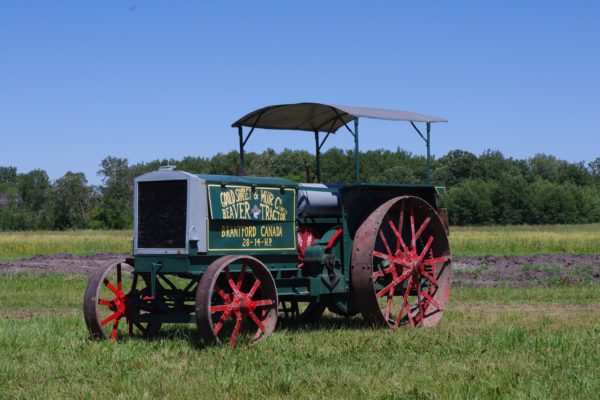
The Beaver tractor in the Museum’s collection was built by the Goold, Shapley and Muir Company (GS&M) sometime between 1918 and 1920.
GS&M was formed from Goold and Company, a manufacturer of beekeeper supplies and refrigerators in 1892. The new company diversified and began to manufacture windmills, gasoline engines, tanks, lookout towers, concrete mixers and pumps. Manufacturing gas engines resulted in GS&M manufacturing tractors. In 1907, the company introduced the “Ideal” tractor line which consisted of two models the 35-18 and 50-25. GS&M was different from other early tractor manufacturers as they listed the belt pulley horsepower first and drawbar horsepower second. GS&M went on to produce the “Ideal Junior” a 24-12 tractor.
In 1918, GS&M replaced the “Ideal” Line with the Beaver tractor which used a Waukesha engine and friction drive transmission. The Beaver line is a close copy of the Rock Island tractor. Both the Beaver and Rock Island tractors used a friction drive transmission, however the Beaver transmission is a mirror copy of the Rock Island transmission for some reason. As a result it operates in an opposite fashion to the Rock Island. As GS&M records are not available, no one is sure whether GS&M arranged with Rock Island to build a copy of the Rock Island tractor. By 1921, GS&M was getting out of building tractors. GS&M continued building other machinery but closed completely in the late 1930s.
Goold Shapely and Muir is important as it is second Canadian manufacturer of tractors. The first Canadian manufacturer of tractors was the Slyvester Company which began experimenting with the Auto-Harvestor in 1904. The Auto-harvestor was a wooden threshing machine mounted on a tractor frame which then could be driven around a field while men on the ground pitched sheaves into it. The threshing body could be removed and the tractor used to pull binders, for plowing or for belt work. The Slyvester Company failed in 1912 due to financial issues.


